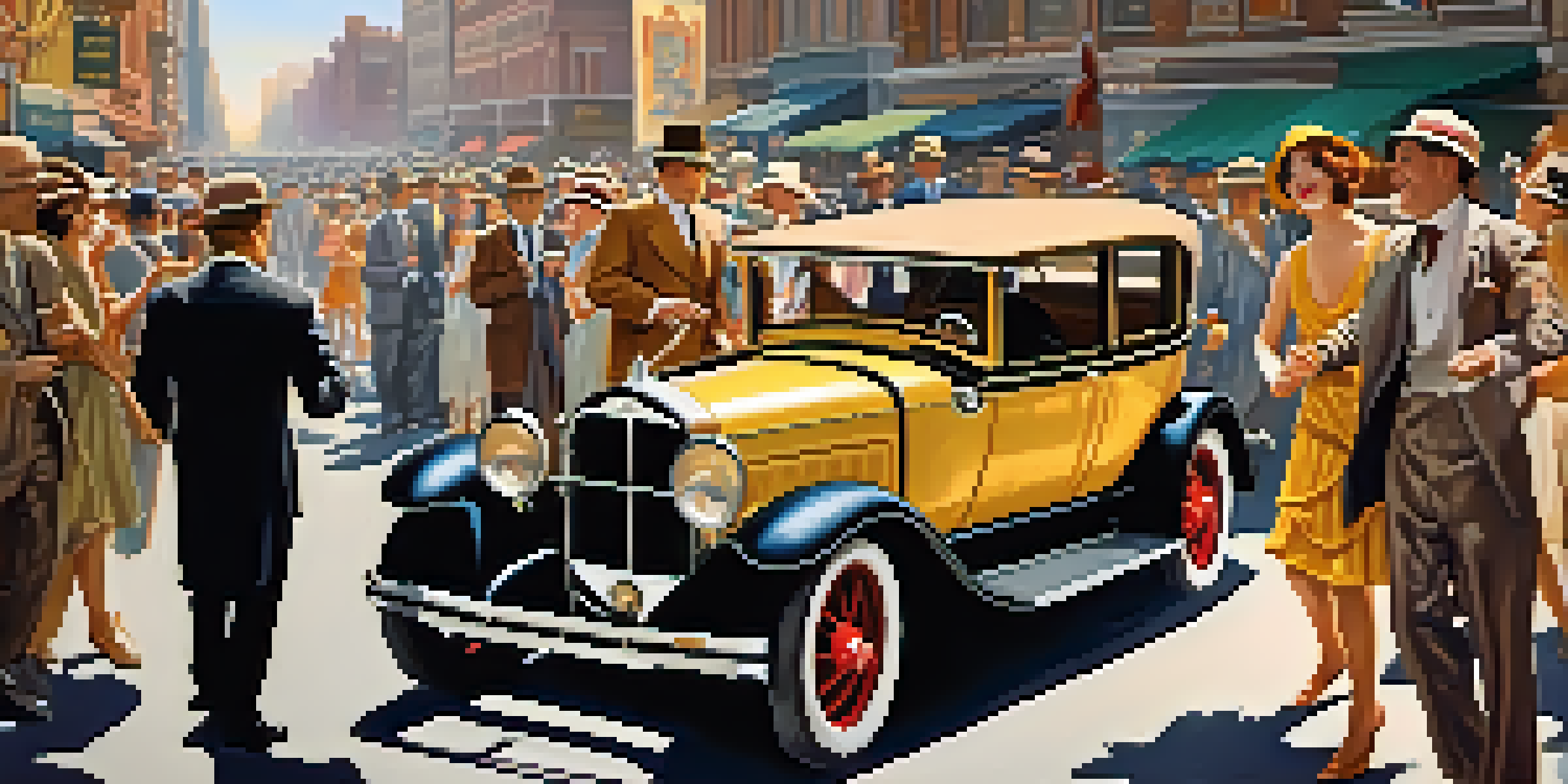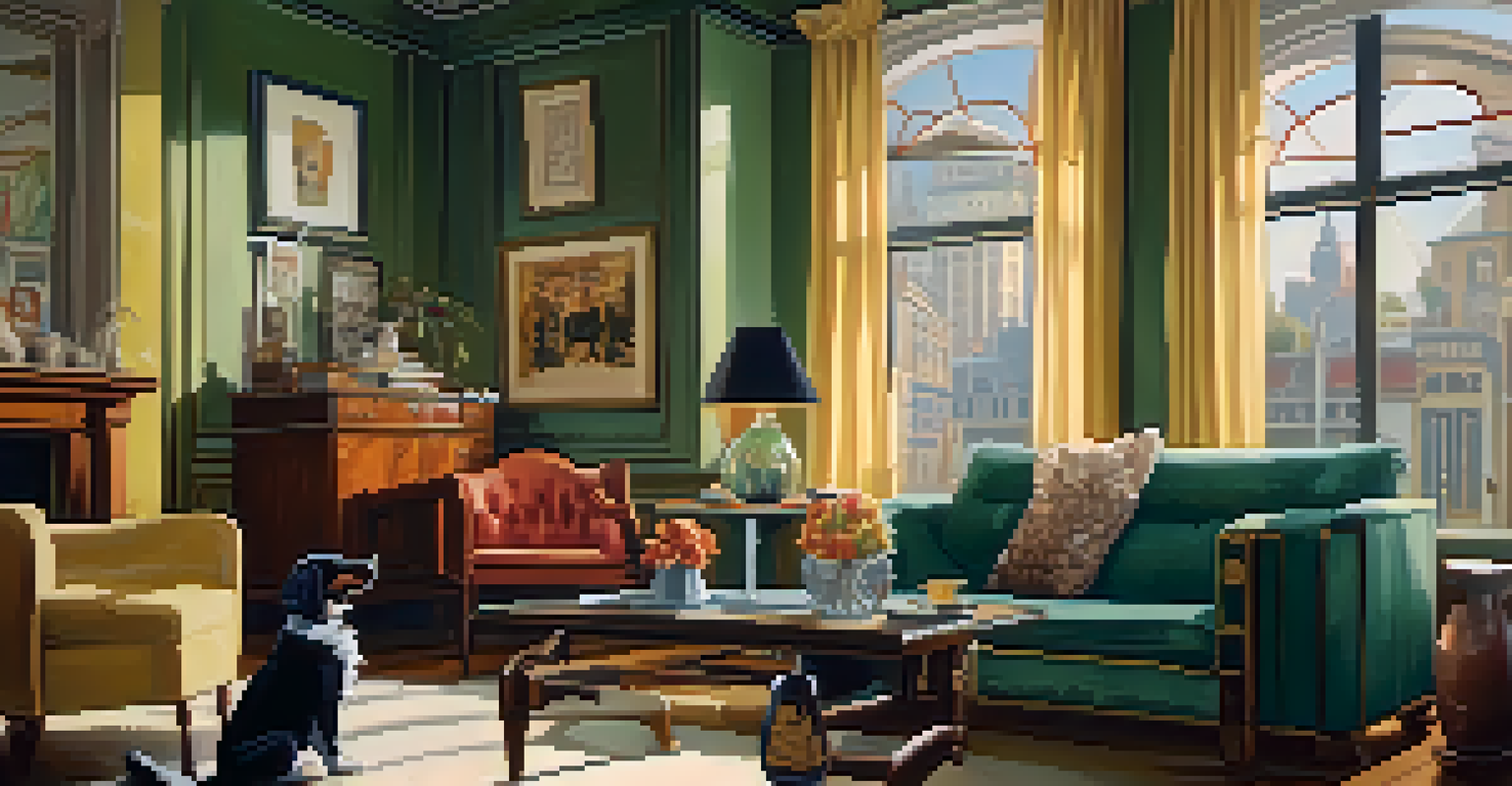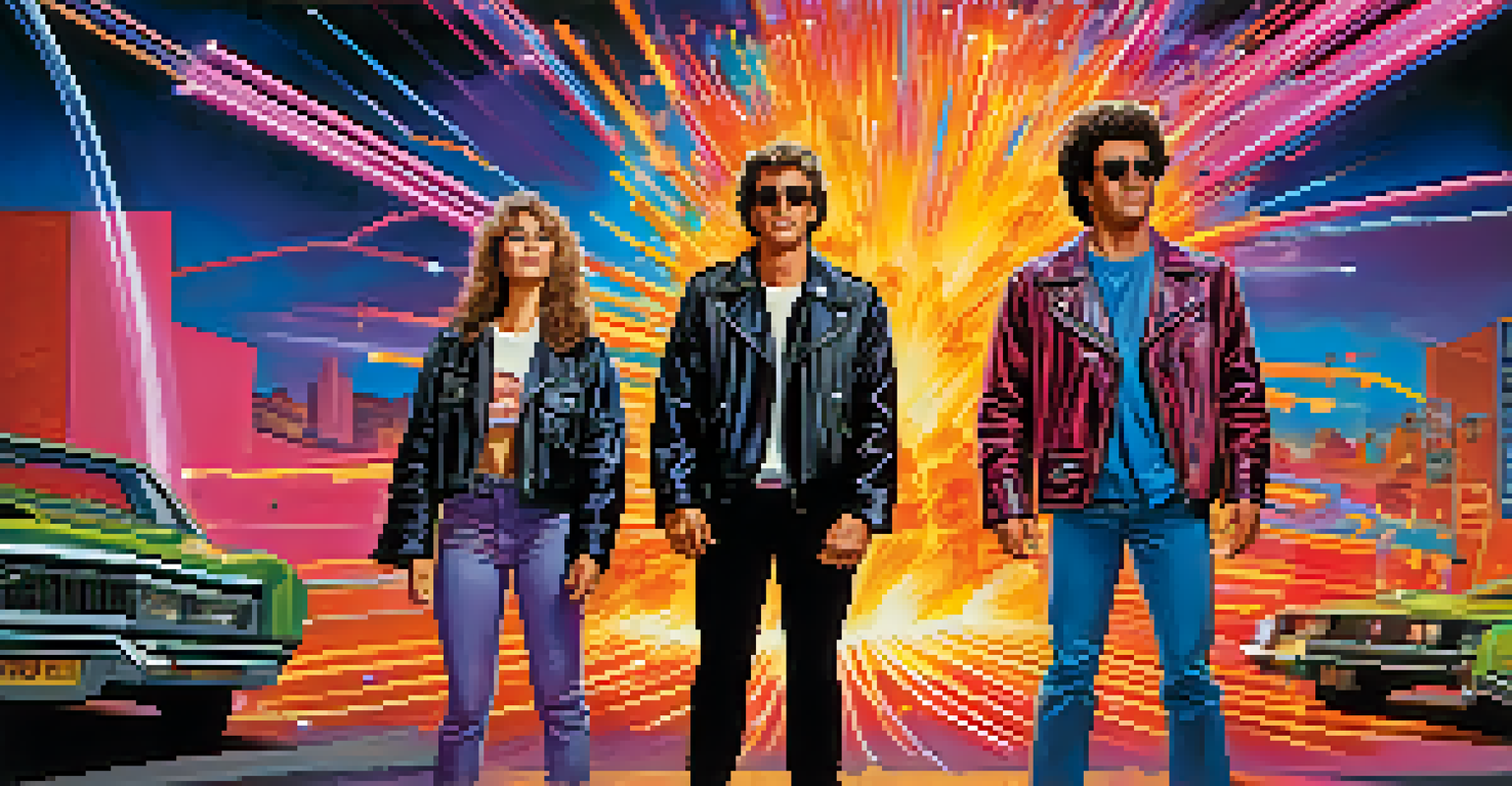The Evolution of Humor in Cinema Through the Decades

The Roaring Twenties: Slapstick and Silent Laughter
The 1920s were a turning point for comedy in cinema, with silent films dominated by physical humor. Icons like Charlie Chaplin and Buster Keaton showcased how a simple gesture could elicit hearty laughter without a single word. Their slapstick routines combined pratfalls with clever timing, proving that humor transcends language. This era laid the groundwork for future comedic styles by emphasizing visual gags and exaggerated expressions.
Comedy is the tragedy that happens to other people.
As the decade progressed, the introduction of sound in film began to change the landscape of comedy. While silent films relied on physicality, talkies opened up new avenues for witty dialogue and character-driven humor. Comedians had to adapt their craft, blending verbal wit with the established slapstick traditions. This evolution marked the beginning of a rich interplay between dialogue and physical comedy that would flourish in subsequent decades.
The 1920s not only set the stage for future comedic innovations but also highlighted the cultural shifts of the time. The carefree spirit of the Roaring Twenties, with its jazz music and flapper fashion, influenced the humor on screen. Audiences were eager for escapism, and films provided a perfect avenue to laugh away the tensions of the post-war world.
The 1930s: The Golden Age of Screwball Comedy
The 1930s ushered in what is often referred to as the Golden Age of Screwball Comedy, characterized by fast-paced dialogue and eccentric characters. Films like "It Happened One Night" and "Bringing Up Baby" showcased a unique blend of romance and humor, appealing to audiences looking for lighthearted escapism amid the Great Depression. This era emphasized witty banter and absurd situations, often flipping traditional gender roles, making women equal partners in the comedic chaos.

Actors such as Katharine Hepburn and Cary Grant became synonymous with this genre, delivering performances filled with charm and comedic timing. Their ability to balance romance and humor created a new dynamic that resonated with viewers. The screwball comedy's hallmark was its ability to tackle serious themes, like class and gender, through a comedic lens, allowing audiences to reflect on societal norms while enjoying a good laugh.
Evolution of Comedy in Cinema
Comedy in cinema has transformed from slapstick and silent films in the 1920s to diverse styles, including screwball and action-comedy hybrids, reflecting societal changes.
As the decade progressed, the blend of humor and romance continued to evolve, influencing future romantic comedies. The emphasis on sharp dialogue and character chemistry set a precedent for storytelling that resonates even today. The screwball comedy’s legacy is evident in modern films, which often borrow elements from this golden era, showcasing the timeless appeal of laughter in love.
The 1940s: Satire and War-Time Humor
During the 1940s, the backdrop of World War II heavily influenced the comedic landscape in cinema. Filmmakers utilized satire to comment on the war and societal issues, creating a unique form of humor that resonated with audiences living through turbulent times. Movies like "To Be or Not to Be" cleverly blended comedy with serious themes, showcasing the resilience of the human spirit even in the face of adversity.
The best way to make your audience laugh is to make them feel comfortable and then surprise them.
The era also saw the rise of comedic actors like Bob Hope, who became famous for his ability to blend humor with patriotic messages. His films often included clever one-liners and situational comedy, making light of serious topics while still promoting morale. This blend of humor and social commentary became a hallmark of 1940s cinema, as filmmakers sought to uplift audiences during trying times.
As the decade closed, the foundation for post-war comedies was laid, paving the way for a new era of humor. The techniques developed during this time influenced the genre of political satire, which would gain popularity in the following decades. The 1940s showed that comedy could serve as both entertainment and a tool for reflection on society's challenges.
The 1950s: The Rise of Television and Family-Friendly Comedy
The 1950s marked a significant shift in the comedy genre with the rise of television, which began to influence film comedy styles. Sitcoms became immensely popular, with shows like "I Love Lucy" capturing the hearts of audiences. This shift led to a new type of humor that focused on everyday family life and relatable situations, emphasizing characters that audiences could connect with.
Film comedies of this era began to adopt similar themes, with stars like Marilyn Monroe and Jerry Lewis leading the charge. Lighthearted plots and comedic antics became staples of the genre, often prioritizing family-friendly content that appealed to a broad audience. The focus on wholesome humor reflected the post-war desire for stability and normalcy in society.
Cultural Influences on Humor
Each decade of comedy has mirrored the cultural and social shifts of its time, from the carefree spirit of the Roaring Twenties to the counterculture of the 1960s.
As television continued to grow in popularity, filmmakers faced competition for audiences' attention. This led to innovative storytelling techniques and a push for more engaging and entertaining content in cinema. The blending of television comedy with film opened doors for future generations of comedians, establishing a legacy that would influence both mediums.
The 1960s: Counterculture and Satirical Comedy
The 1960s brought a wave of counterculture that significantly impacted the humor found in cinema. As societal norms were challenged, filmmakers began to embrace satire and absurdity in their storytelling. Movies like "Dr. Strangelove" used dark humor to critique political tensions, showcasing how comedy could tackle serious issues with a light-hearted twist.
This decade also saw the emergence of new comedic voices, including the likes of Woody Allen and Mel Brooks, who pushed boundaries and explored unconventional themes. Their unique styles reflected the changing cultural landscape, as audiences sought humor that resonated with their experiences of rebellion and social change. The era's humor often combined wit with a sense of irony, making it both entertaining and thought-provoking.
The comedic trends of the 1960s laid the groundwork for future generations of filmmakers to explore satire and social commentary. This evolution demonstrated that humor could serve not only as entertainment but also as a reflection of the times. The decade's influence continues to be felt today, as many contemporary comedies still embrace the spirit of irreverence and social critique.
The 1970s: The Birth of the Buddy Comedy
The 1970s introduced a new breed of comedy known as the buddy comedy, characterized by the dynamic between two mismatched characters. Films like "Butch Cassidy and the Sundance Kid" and "The Odd Couple" showcased the comedic chemistry that arises from contrasting personalities. This genre allowed audiences to experience humor through friendship, often highlighting the absurdity of everyday life.
The decade also saw a rise in more adult-oriented comedies, as filmmakers pushed boundaries with raunchier humor and social commentary. Movies like "Animal House" and "Blazing Saddles" broke away from traditional norms, appealing to a younger audience eager for a fresh take on comedy. These films embraced a more irreverent style, often using shock value to elicit laughter.
Digital Era and New Humor Styles
The rise of digital media has led to innovative comedic formats, such as mockumentaries and short-form content, adapting humor to our fast-paced, technology-driven society.
As the buddy comedy gained traction, it paved the way for countless iconic films in the following decades. The combination of camaraderie and humor resonated with audiences, creating a template for successful comedic storytelling. The 1970s exemplified how comedy could evolve alongside societal changes, reflecting both the humor and challenges of the time.
The 1980s: The Rise of the Action-Comedy Hybrid
The 1980s saw the emergence of a unique genre that blended action and comedy, giving birth to the action-comedy hybrid. Films like "Beverly Hills Cop" and "Ghostbusters" combined thrilling plots with laugh-out-loud moments, appealing to audiences looking for both excitement and humor. This genre demonstrated that comedy could thrive within the framework of action-packed storytelling.
Stars like Eddie Murphy and Bill Murray became household names, showcasing their ability to navigate both comedic and action-packed roles seamlessly. Their performances highlighted the versatility of comedy, as they brought laughter to high-stakes situations. This era's humor often relied on clever one-liners and witty banter, adding a layer of fun to the action genre.

The popularity of action-comedy films laid the groundwork for future blockbusters, as filmmakers recognized the potential for combining thrills with laughs. This hybrid approach continues to influence cinema today, with many modern films adopting the same formula. The 1980s highlighted how humor could elevate a story, making it more engaging and entertaining for audiences.
The 1990s to Today: The Digital Shift and New Forms of Humor
The 1990s marked the beginning of a digital shift in cinema, leading to new forms of humor that embraced technology and cultural shifts. The rise of the internet and television influenced comedic styles, with films like "The Big Lebowski" incorporating elements of absurdism and postmodern humor. This era showcased a departure from traditional storytelling, embracing a more unconventional approach to comedy.
As the 2000s rolled in, filmmakers began experimenting with new formats, including mockumentaries and meta-humor. Movies like "This Is Spinal Tap" and "Borat" blurred the lines between reality and fiction, creating a unique comedic experience that resonated with audiences. The evolution of humor reflected a society increasingly influenced by media and technology, showcasing how comedy adapts to cultural changes.
Today, the landscape of humor continues to evolve with the advent of streaming platforms and social media, where short-form content reigns supreme. Comedians now have the ability to reach audiences directly, leading to a democratization of humor. As we look to the future, it's clear that the evolution of humor in cinema will continue to reflect the complexities and nuances of modern life.